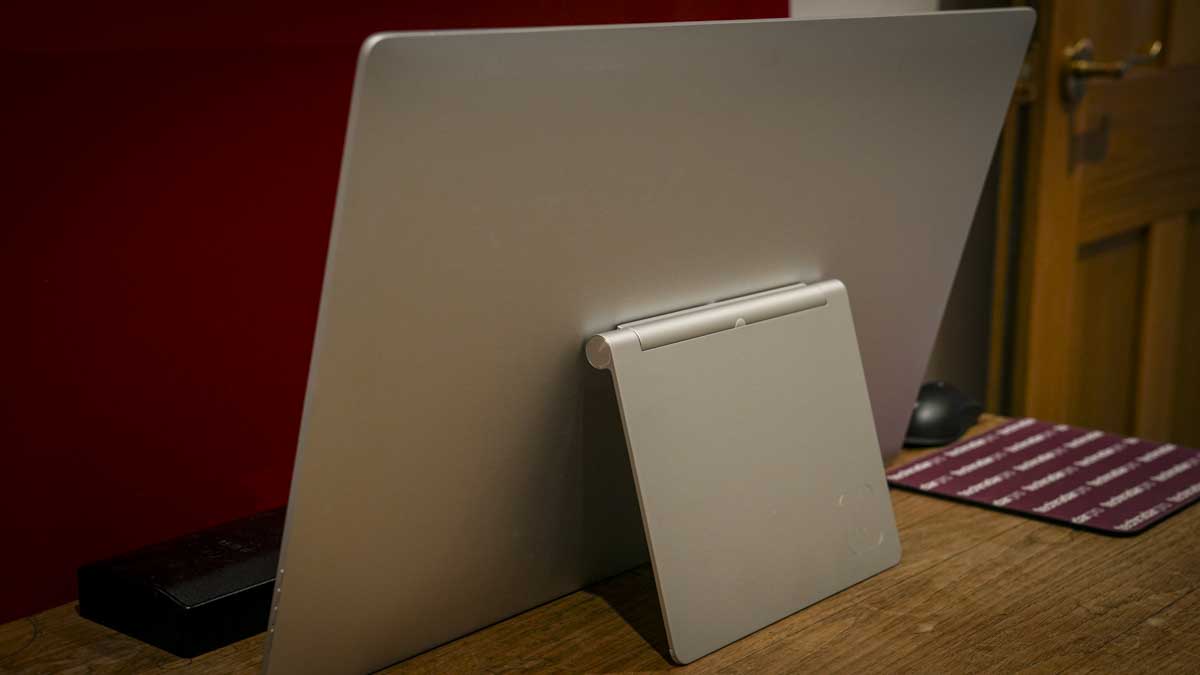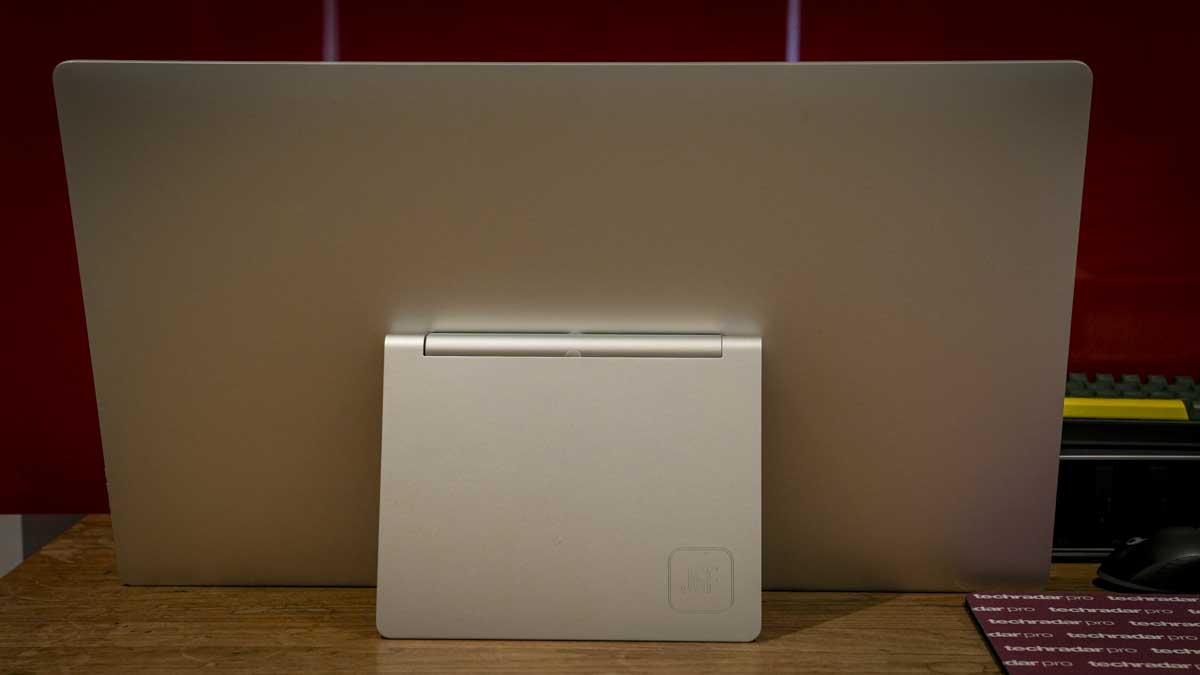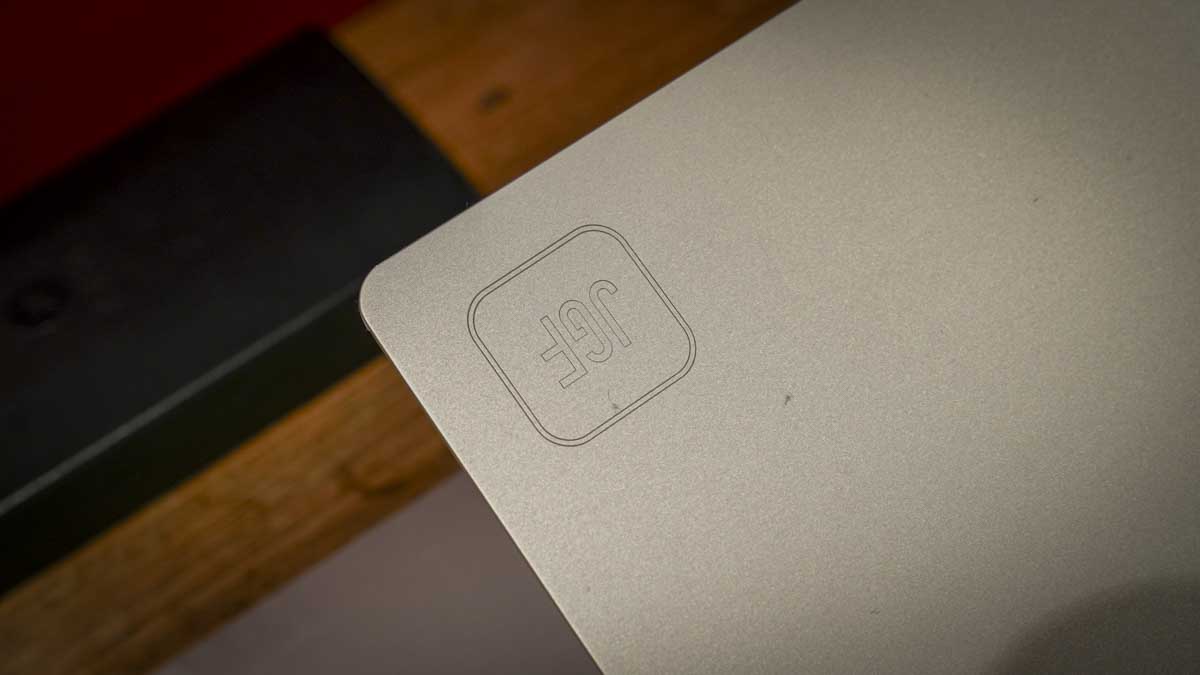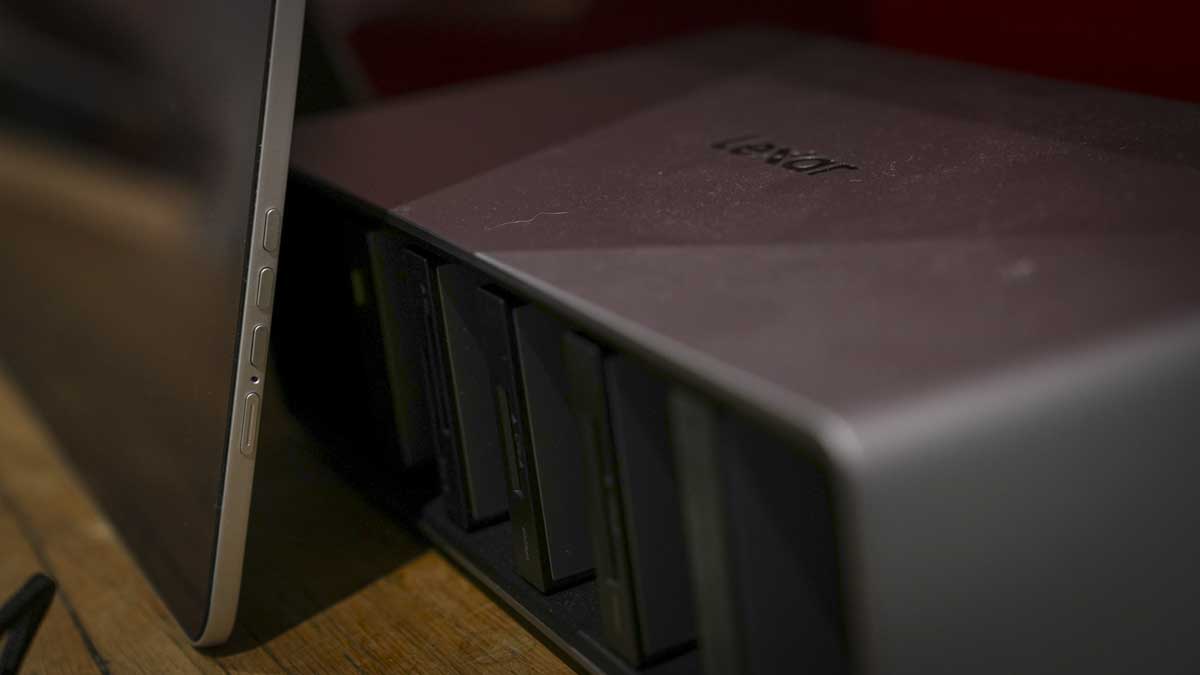Why you can trust TechRadar
We spend hours testing every product or service we review, so you can be sure you’re buying the best. Find out more about how we test.
JGF 27-inch 4K monitor: 30-second review
This is a monitor built to impress. The 27-inch screen gives you plenty of real estate for most creative applications, and with a huge native 4K resolution and support for 100% sRGB, 99% DCI-P3, and 98% Adobe RGB, this ultra-slimline monitor couldn’t be more tuned to the creative workflow.
The styling is instantly reminiscent of Apple products and is the perfect partner for any of the latest Mac Minis, Studios or even a MacBook Pro, as I’ve used in this hands-on review.
While this early sample isn’t a final production model, and a few features hadn’t been fully unlocked, the potential of this monitor was instantly apparent. As soon as it was plugged into the 16-inch MacBook Pro M1 Max via USB-C and power supplied by the 100-watt adapter, the display flickered to life with incredible resolution and clarity.
During testing, I used a host of creative apps, including Photoshop, Lightroom and Final Cut Pro X, for a large video project. The screen real estate made a big difference, especially with the monitor taking up little room on my desktop compared with my standard 4K monitors.
One thing that really appealed to me with this monitor was the preset profiles. Through the menu, you can switch between Adobe RGB for image enhancement and BT.2020 when using Final Cut Pro X, ensuring consistency whether I was enhancing colour in images or grading video for TV or film.
A big selling point is its compatibility. The onscreen display offers far more adjustment options than most monitors, clearly showing that JGF has considered end users and the various workflows users will need.
After a few weeks of use, it’s clear this monitor is aimed at the professional market. While the styling may appeal to home users and gamers, the high resolution, colour gamut options and 60 Hz refresh rate will likely be overkill for general users and fall short for gamers.
It’s also worth noting that this isn’t a fully finished product yet. Some features weren’t accessible, and a touchscreen version is in the pipeline, which I’d be keen to test in future. As it stands, this is a very slimline, stylish monitor that’s one of the best monitors for the Mac mini (and any other Mac for that matter), and it’s certainly very appealing.
JGF 27-inch 4K monitor: Price and availability
- How much does it cost? TBA
- When is it out? TBA
- Where can you get it? Available soon through the Kickstarter campaign
At present, the Kickstarter campaign hasn’t launched, so there are no pricing options available, but they should be announced shortly. You can check out the Kickstarter by clicking here.
JGF 27-inch 4K monitor: Design

Specifications
Size: 27-inch
Resolution: 4K / 3,840 x 2,160 native resolution
Colour gamut: 100% sRGB, 99% DCI-P3, 98% Adobe RGB
Ports: Port 1 USB-C input, Ports 2 and 3 USB-C
Refresh rate: 60 Hz
Supports: HDR400
Think Apple-style design, and that pretty much sums up the JGF 27-inch 4K monitor. It’s extremely stylish, with a very low bezel around the outer edge. It’s finished in the usual light matte silver that blends perfectly with my MacBook Pro.
Physically, it measures 625 mm horizontally and 364 mm vertically, with a depth of around 10 mm, not including the stand. It weighs 3.89 kg. While it might not be designed for travel, the fact you can supply power and display via two separate USB-C ports makes it more portable than most 27-inch monitors.

The front is almost entirely screen, with a thin 12 mm metal frame. On the left-hand side are three USB-C ports. The top is input-only (possibly subject to change in the final version), while you can use the other two for power and connecting to your machine.
On the right side are the four menu control buttons. A quick press brings up the menu, with the top button as Enter, the two middle buttons for navigation, and the bottom one to exit.
The onscreen display is extensive, offering plenty of image adjustment. On the back of the monitors, there’s a built-in flip-down stand, and a VESA bracket is included in the box, allowing for wall mounting. The overall build is solid, all-metal, and features a well-balanced glossy screen that keeps reflections to a minimum. It’s also worth noting that a touchscreen version is planned for full compatibility with Apple and other systems.

JGF 27-inch 4K monitor: Features
JGF has aimed to design an affordable, Apple-style monitor with a large screen that is suited for use in tight spaces, ideal for creatives working from home.
It features a 27-inch native 4K resolution of 3840 x 2160, and despite this high spec, it is designed to be as slim as possible and features a compact fold-out stand at the back, enabling it to sit neatly on your desk.
During testing, it took up only 12 cm of depth. Then, when I needed full desktop space, I could simply fold down the stand, quickly disconnect the USB-C cables, and it would lift easily aside, far quicker than with my standard 4K monitor.
If you want to VESA-mount it, the fold-out stand can be removed and replaced with the included bracket. Wall-mounted, it protrudes just a few centimetres as long as you fit a slimline mount.
The monitor will be launching on Kickstarter with two versions: non-touchscreen (tested here) and touchscreen. The touchscreen version will be pre-configured for Apple OS gestures; Windows gesture support will be more limited, again underlining the Mac-focused design.
The 60 Hz refresh rate may deter gamers, but for creatives, the wide colour support is more relevant. The box includes a 100 W USB-C power adapter and a USB-C display cable.
Screen features include OGS technology, nano-textured glass, five-layer AR+AF, a 1,000,000:1 contrast ratio, and high accuracy. The gamut includes 100% sRGB, 100% NTSC, 99% DCI-P3, 80% BT.2020, and 98% Adobe RGB, again all highly relevant to creatives.
The monitor that I have looked at is the non-touch version, so I can’t comment on touch features. However, the literature mentions scroll, zoom, app support and Mission Control. OGS touch tech will offer 4,096 pressure points and a 10-point touch for interaction customisation and it will support iPhone and Android devices.
This is a pre-production model and while impressive, it’s unclear whether supporting software or gesture customisation will be included. I’ll update once we test the final model.

JGF 27-inch 4K monitor: Performance

As a pre-production sample, I tested the monitor with Lightroom, Photoshop and Final Cut Pro. I’m currently finishing images for a book, and with several hundred to go through, the 4K resolution and added screen space made a significant difference when using Adobe Bridge and blending layers in Photoshop.
Out of the box, the colours were visibly off, but adjusting the onscreen display to gamma 2.2 from 2.4 and switching to the Adobe RGB profile helped to correct to pretty good standard. I then ran Datacolor Spyder X2 to calibrate it with my Mac workflow.
The monitor was recognised instantly by the software and allowed solid profile creation. After calibration, the screen matched my MacBook Pro in quality. I used the MacBook’s screen for emails and browsing, while the JGF handled Photoshop with all palettes laid out. The extra space made the MacBook Pro’s 16-inch display feel decidedly cramped. As you’d expect from any of the best monitors for photo editing, the JGF also gave a better sense of tone and dynamic range, especially when viewing images at 100%.
Switching to video editing, I changed the colour profile to one suitable for online video. My footage was 60 FPS, so the 60 Hz refresh rate was ideal. There was no judder, and the colour profile complemented the video work.
It might be one of the best monitors for video editing, except, for slow-motion work (125 FPS), a higher refresh rate would be helpful. 60 Hz is still standard for creative work, so it makes sense, but 120 Hz would’ve been nice to have.
Overall, it performed exceptionally well in image and video apps. The onscreen display offered deep adjustment options. There were a few glitches, mainly a high-pitched noise from the back and shallow USB-C ports, causing a loose fit. Likely due to the pre-production nature.
JGF 27-inch 4K monitor: Final verdict

This hands-on test shows that, while this monitor appears finished with its aluminium frame and high-resolution screen, it still needs some snagging before the final product. Small issues remain, USB-C plugs don’t sit flush, affecting connections with MacBooks or Mac Minis, and there’s a slight squeal from the cooling system.
No included software yet, which is common for creative monitors so you can easily switch profiles, and better sync with monitor calibrators such as the Spyder X2.
I liked the fast profile switching (e.g. Adobe RGB to BT.2020) and compatibility basic compatibility with Spyder software, making it ideal for creative workflows.
Also impressive is how little space it takes up—far less than my BenQ 4K monitor. For creatives where space is limited, it’s a practical choice.
If you run a dual or triple monitor setup with VESA mounts, this could be a good fit. Compared to Apple’s £1,500 monitor, this should be more affordable for creatives already investing heavily in hardware.
Should I buy the JGF 27-inch 4K monitor?
|
Value |
With Apple’s monitor at around £1,500, anything cheaper of this quality is good |
/ |
|
Design |
Undeniably influenced by Apple, the aluminium casing and sleek design look superb |
5 |
|
Features |
If you were to write a monitor feature wish list, the JGF ticks nearly every box |
5 |
|
Performance |
Hands-on performance is strong, but a few glitches and reliability concerns remain |
4 |
|
Overall |
Potentially a superb monitor—we’ll have to wait for the final retail version |
4.5 |
Buy it if…
Don’t buy it if…
For alternatives you can get right now, we’ve reviewed all the best monitors for the MacBook Pro and the best monitors for the Apple Mac Studio.

